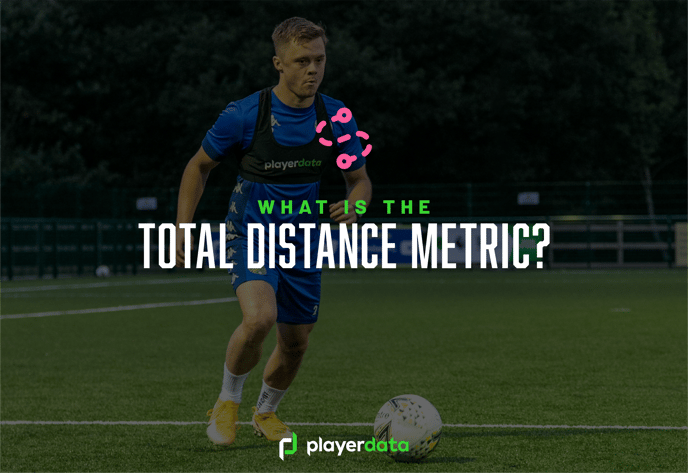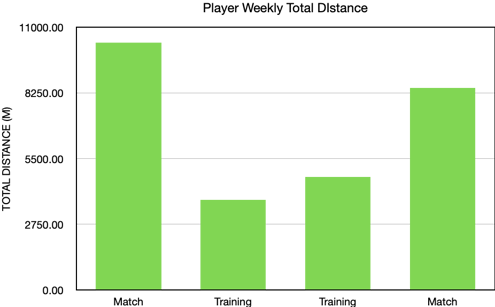What is the Total Distance metric?
What is the total distance metric and why is it useful for improving performance?
 What does it Measure?
What does it Measure?
Training Session – Total Distance is the distance covered during the session with out any restrictions such as pitch or half time
Match session – Distance during matches is measured slightly differently than training, The total distance will only count what distance has been covered on the pitch and during the timings selected.
How to better understand the Metric?
The total distance metric measures a players total distance covered on the pitch throughout a match or training session. This may seem like a simple metric at first glance but it can give insight into what work was put in over the session, especially when we pair it with other metrics too!
Total distance is a useful metric to track players training load throughout the week. For example, in the graph below it shows a players total distance covered at each session throughout the week. The first bar shows a high total distance on match day (10,340m) . The mid week training bars show a reduction in total distance with less than half of that covered in the match. This lowered distance covered is expected as players will be recovering in preparation for the match as the end of the week.These low total distance sessions will be low impact and may focus more on skills and technical parts of the game in training to ensure players are not fatigued. The final session of the week is a match with a high total distance which suggests players prepared effectively throughout the week.

Figure 1- Total distance covered for a player throughout a week of sessions.
By tracking players total distance across a season of matches coaches can use this data to monitor their performance and progression of their workload. It can also highlight if a player is at risk of burnout on injury. For example if players workload is increasing rapidly over a short period of time and are covering a high total distance in matches and training throughout.This may put them at major risk of an injury. Previous studies have found that a 15% workload increase week to week can increase the risk of injury for a player by 50% (1). Therefore it is key to monitor players volume in sessions to identify any players at risk.
Total Distance is a key metric for understanding the volume of a session but paired with other metrics can give you a broader understanding of the work a player has done. For example, if your distance is quite high but your top speed is slower than usual with few sprints, this indicates you’ve done a high-volume session but probably not high intensity. A High intensity session would have more ‘high speed distance’ and might have lower total distance.
Data, paired with knowledge of the session, can tell you a lot about your players too. If you have a player usually hitting average session distances that seems to be decreasing a lot over time, why is that? Can you ask them? Using data as a tool to understand your players can go a long way in reducing the risk of injury, as well as increasing performance in the long run!
What should players be aiming for?
Football Elite Mens 10938m ± 590
Central Defender 10058m ± 395
Wide Defender 10852m ± 463
Central Midfield 11848m ±540
Wide Midfield 11503m ± 603
Attacker 10819m ± 725
Football Elite Women's 10369m ± 674
Central Defender 9677m± 516
Wide Defenders. 10334m ±550
Central Midfield 10905m ± 613
Wide Midfield 10690m ±681
Attackers 10257m ± 715
Football Playerdata Average (women’s)
COMING SOON
Football Playerdata Average (Men’s)
COMING SOON
Rugby Elite (Men's)
Forwards 5734.4 ± 693.7
Backs 6261.6 ± 745.2
Tight Forwards 5352.9 ± 798.6
Loose Forwards 6155.9 ± 588.8
Half Backs 6620.9 ± 784.4
Inside backs 6081.6 ± 779.4
Outside backs 6079.5 ± 617.7
Rugby Playerdata Average (Men’s)
COMING SOON
Rugby Playerdata Average (women’s)
COMING SOON
GAA Elite
Defenders 7125m
Midfielders 7969m
Forwards 6740m
Totals 7278m
GAA Playerdata Average
COMING SOON
REFERENCES
1. Gabbett TJ.: The training—injury prevention paradox: should players be training smarter and harder?, Br J Sports Med, 50:273–280 2016.
